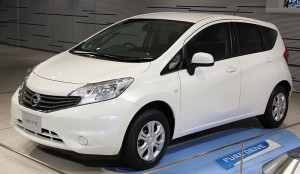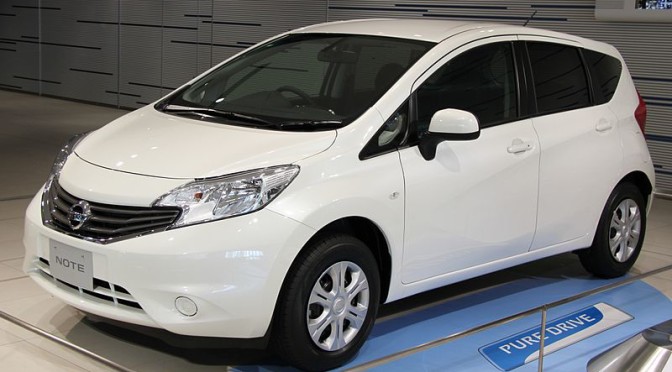The Nissan Versa Note, the hatchback wagon version of the Nissan Versa, is one of the more popular entries in the subcompact (minicar) market in the United States. Buyers like it because it’s one of the cheapest cars you can buy new today in the US, and because it’s also pretty reliable and a decent deal for the money. It competes with a range of other gas-sippers like the Toyota Prius C, Honda Fit, Toyota Yaris, Ford Fiesta, Hyundai Accent, Kia Rio, and Chevrolet Sonic.
The funny thing about the Versa Note is that it’s actually been available in other countries for a number of years (since 2004), where it’s known simply as the Nissan Note. However, Nissan decided to split the sedan and hatchback lines recently for the US market and rebadge the overseas Note as the Versa Note here in the US. Time will tell if they see success with this approach.
I had the privilege of borrowing a Versa Note this weekend in order to see if I could squeeze some car seats into it. The bad news is that it wasn’t an easy task, but the good news is that was possible at all. This is one of those cars that’ll make you be thankful for narrow seats by the time you’re done with a successful 3 across installation. First, though, let’s look at which kinds of seats are good to use in various stages of development.
First of all, try to rear-face your kids as long as you can (ideally until 4!), before forward-facing them in harnessed convertible or combination seats (ideally until 8!). Rear-facing offers the greatest protection for kids of all ages, and there are a number of seats (such as the Fllo / Foonf) that will let them rear-face through the preschool years. Once they outgrow their harnessed seats, I suggest keeping them in high-back boosters until they’re physically and psychologically ready to use adult seat belt systems (which typically happens between 10 and 12). What we want to do is keep our kids restrained in the safest positions for as long as possible to increase their odds of surviving crash forces.
Keeping these ideas in mind, I set to work to find which infant, convertible, combination, and booster seats would work best in 3 across combinations in the Nissan Versa Note. I found several good options and a few great ones. If you find the list helpful when shopping for car seats, you can shop through my Amazon link below. I’ll add more seats as I test them over time.
You can access the complete 3 across guide for every vehicle here and the complete list of recommended seats here. The Canadian car seat guide is here. 3 across car seat images are courtesy of Wikipedia.
 2014, 2015, 2016, 2017 Nissan Versa Note (E12)
2014, 2015, 2016, 2017 Nissan Versa Note (E12)
Guaranteed 3 across installations:
Clek Fllo (x3).
Clek Foonf (x3).
Chicco KeyFit 30 (x3).
Clek Oobr (x3).
Diono Radian RXT (x3).
Diono Radian R120 (x3).
Diono Radian R100 (x3).
Combi Coccoro (x3).
Tips and Tricks:
The current generation of the Nissan Versa Note is 162 inches long and 67 inches wide, making it one of the narrowest vehicles I’ve ever tried to stuff 3 car seats into. However, it’s definitely possible if you use the seat belts (no way no how when it comes to LATCH) and take your time.
Out of the above convertibles, to be honest, I’d really just go with the Fllo or Foonf, as the Radians will take up a lot of front-to-back space that you really don’t have, while the Coccoro won’t be the best value for your money unless you have the specific needs to merit it over the Fllo / Foonf. If you insist on using one of the Radians, you’ll definitely need the angle adjuster, or you’re not going to have much front-passenger space, and it’ll be a painful experience for tall drivers or passengers. If you’re looking for infant / bucket seats, the KeyFit 30 is a good narrow choice.
—
If you find the information on car safety, recommended car seats, and car seat reviews on this car seat blog helpful, you can shop through this Amazon link for any purchases, car seat-related or not. Canadians can shop through this link for Canadian purchases.


